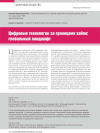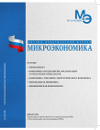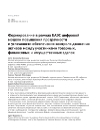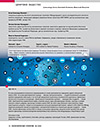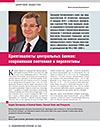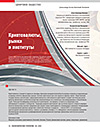Digital Technologies Beyond Hype: The Global Landscape
DOI: https://doi.org/10.33917/es-6.186.2022.104-110
The paper discusses three key issues that play a special role in the development of strategies and policies for digital technologies: 1) particularities of digital technologies that greatly influence the principles and methodological approaches to the development of strategic documents, 2) drivers, main players and trends of global market, 3) trends in the accumulation of a technological knowledge base to provide competitive advantages to national companies in the short and medium term.
References:
1. Gaponenko N.V., Glenn J.C. Technology Industry 4.0: Problems of Labor, Employment and Unemployment. Studies on Russian Economic Development, 2020, vol. 31, no 3, pp. 271–276.
2. Gaponenko N.V. Teoreticheskie i metodologicheskie osnovy issledovaniya innovatsionnykh sistem i formirovaniya tekhnologicheskikh prioritetov ikh razvitiya v ekonomike, osnovannoi na znaniyakh [Theoretical and Methodological Foundations for Studying Innovative Systems and Forming Technological Priorities of their Development in the Knowledge-Based Economy]. Moscow, IPRAN RAN, 2020, 151 p.
3. Gaponenko N.V. Zakonomernosti i osobennosti evolyutsii sektoral’nykh innovatsionnykh sistem v ramkakh dolgosrochnogo tsikla [Regularities and Evolution Features of Sectoral Innovation Systems within the Long-Term Cycle]. Systems and Management, 2020, no 1, pp. 44–67.
4. Gaponenko N.V. Sektoral’nye innovatsionnye sistemy v ekonomike, osnovannoi na znaniyakh [Sectoral Innovation Systems in the Knowledge-Based Economy]. Moscow, IPRAN RAN, 2021, 264 p.
5. Going Digital: Shaping Policies, Improving Lives. Paris, OECD Publishing, 2019.
6. IT Industry Outlook 2021. CompTIA, 2020.
7. Gaponenko N.V. Global’nye vyzovy v formirovanii politsentrichnogo mirovogo poryadka: traektorii retro i traektorii budushchego [Global Challenges in Formation of a Polycentric World Order: Retro Trajectories and Trajectories of the Future]. Ekonomicheskie strategii, 2020, vol. 22, no 1(167), pp. 28–35, DOI: https://doi.org/10.33917/es-1.167.2020.28-35/
8. Positive 5G Outlook Post COVID-19: What Does It Mean for Avid Gamers? Forest Interactive, 2020.



